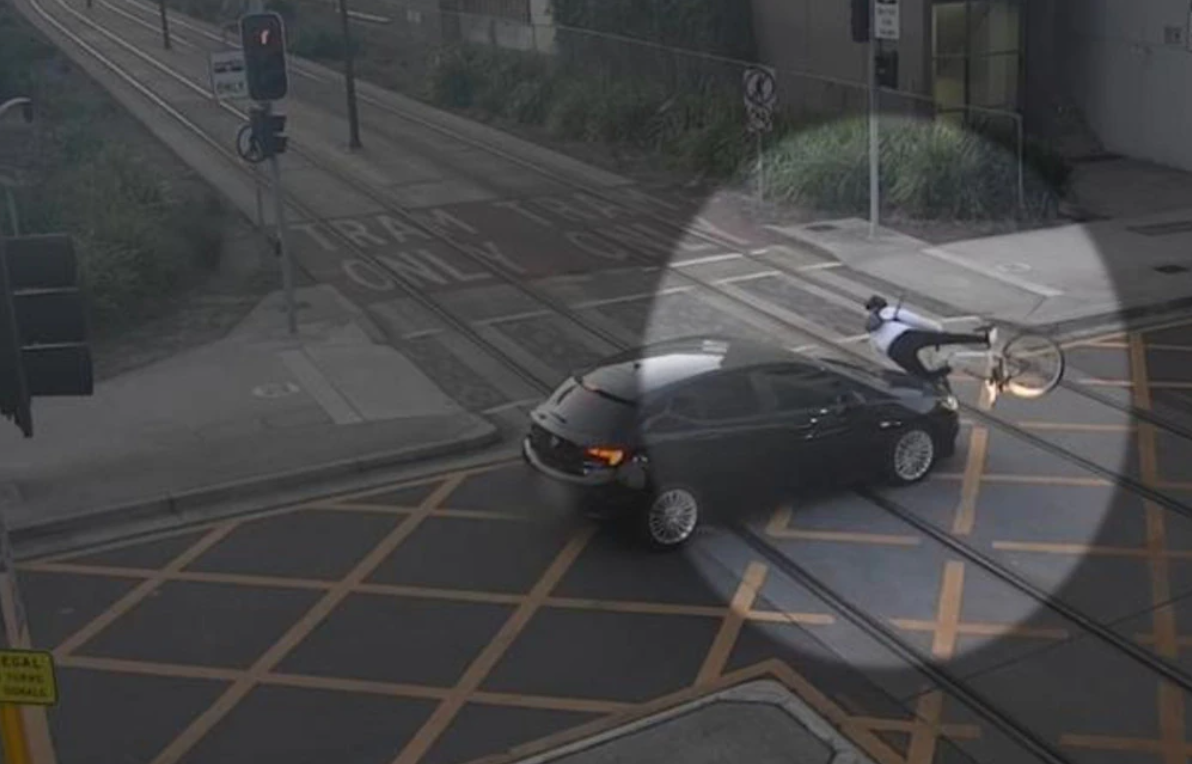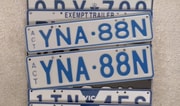
Nearly 65 years after Sydney's last tram clanged down the tracks in 1961, they're back with a vengeance - and so are the safety headaches. Heart-stopping CCTV footage released by Transport NSW during this year's Rail Safety Week shows the daily reality facing tram drivers across Sydney's expanding light rail network: cars darting into their path, pedestrians walking oblivious into danger, and near-misses measured in centimetres and split seconds.
The compilation of close calls, described by officials as 'hard to watch,' captures the moment tram drivers slam their brakes as reckless road users treat the 85-tonne vehicles like they can stop on a dime. Between 2016 and 2024, there were nine fatalities and 994 injuries on Australia's light rail networks, with the bulk occurring in Melbourne's extensive system. But it's Sydney's newest addition - the Parramatta Light Rail, which opened to the public on 20 December 2024 - that's seeing the most concerning trends.
'These moments are hard to watch because in some cases there is just centimetres or milliseconds from the result being so much worse"
In this Article
The 'use your eyeballs' reality check
According to government figures, the Parramatta system has recorded more vehicle near-misses in the past 12 months than other lines, as Western Sydney adjusts to the new transport format. Transport NSW's blunt social media response to concerned viewers - 'Use your eyeballs, people!' - might sound flippant, but it reflects a genuine frustration with dangerous behaviour around these quiet, heavy vehicles.
The footage, captured across Sydney, Newcastle, and Parramatta systems, shows a troubling pattern: drivers treating trams like regular traffic, pedestrians crossing without looking, and cyclists cutting across tracks at the worst possible moments. What makes this particularly concerning is that modern trams are much quieter than their historical predecessors, yet they're just as deadly when things go wrong.
The price of poor decisions
The consequences of these near-misses extend far beyond heart-stopping moments. NSW has implemented hefty penalties to discourage dangerous behaviour around light rail, but many people remain unaware of just how expensive a momentary lapse in attention can be.
What it costs to ignore tram safety in NSW
Pedestrians crossing illegally: $76 fine
Drivers not giving way to trams: $344 fine + 3 demerit points
Not giving way to pedestrians at stopped trams: $191 fine + 2 demerit points
Driving in the tramway: $344 fine + 3 demerit points
Between October 21 and November 14, NSW Police issued 162 fines targeting light rail infringements, suggesting the problem is widespread enough to warrant dedicated enforcement operations.
Why this hits closer to home for seniors
For Australians over 60, these safety concerns carry extra weight. Medications, vision loss, neurological disorders and reduced mobility can all make older adults more vulnerable to accidents, and trams present unique challenges that buses and cars don't.
Modern light rail vehicles are very quiet and smooth, with noise levels remaining low even at maximum speeds of 70km/h. To alert members of the public of their approach, they're fitted with audible warnings (both horn and bell) and high-intensity headlights, but these safety features only work if people are paying attention.
Essential tram safety tips for seniors
- Remove headphones and put away mobile phones when near tracks
- Always look both ways twice before crossing - trams can come from either direction
- Cross tracks at 90-degree angles to avoid wheels getting caught
- Stand well behind yellow platform lines while waiting
- Never cross directly in front of or behind a stopped tram
- If you have mobility aids, cross straight over the tracks to prevent wheels catching
The challenge is compounded by the fact that many seniors lived through Sydney's original tram era and remember when the network was dismantled. The return of trams to Sydney streets after such a long absence means navigating new safety realities around familiar technology.
When Sydney said goodbye (and hello again) to trams
The irony of today's safety campaigns isn't lost on those who remember Sydney's tram heyday. The Sydney tramway network served the inner suburbs from 1879 until 1961, becoming the largest in Australia and the second largest in the Commonwealth of Nations after London. At its peak during the 1930s, about 1,600 trams were in service at any one time.
The final tram service completed its journey on 25 February 1961, when R1 class tram 1995 returned from La Perouse to Randwick Workshops just before 4:40pm. Within days of Sydney's last tram running, road traffic congestion due to the motor car had begun.
Did you know?
Did You Know?
Sydney once had one of the world's most extensive tram networks, stretching 290km at its peak in 1933. The system was so comprehensive that Sydney was the only Australian city to use all four recognised forms of tramway power: horse, steam, cable, and electric. Trams didn't return until 1997 with the Inner West Light Rail service.
The decision to remove trams was driven partly by the perception that they caused traffic congestion - ironically, the same congestion that today's light rail is designed to alleviate. In many ways, the Sydney tram system was a victim of its own success. The overcrowded trams, running at high frequency in competition with growing private motor car use, ended up being blamed for the congestion caused by cars and unregulated private bus operators.
Rail Safety Week puts spotlight on behaviour
Rail Safety Week is an Australasian public safety campaign held every year in the second week of August, raising awareness on how to stay safe near level crossings and light rail since 2007. This year marks the 19th Rail Safety Week, with more than 100 organisations uniting to remind the community to act responsibly on and around the rail network.
The national campaign celebrates its 20th anniversary of raising awareness about safe behaviour around trains and light rail vehicles, with Transport Canberra joining for the seventh consecutive year since light rail began operation in the ACT.
The timing of NSW's footage release wasn't coincidental. Rail Safety Week is designed to engage the community in safe rail practices, featuring tailored information campaigns for regional and metropolitan areas that cover the unique nature of potential interactions with rail networks in city and country settings.
What's next for light rail safety
In the 2023-24 financial year, 40.59 million passenger journeys were made on Sydney's light rail network, equating to over 110,000 journeys per day. With $2.1 billion committed to stage two of Parramatta Light Rail and continued expansion planned, these safety messages become increasingly critical.
The challenge isn't just about enforcement - it's about changing decades-old habits in a city that forgot how to live with trams. Unlike buses that can swerve or cars that can brake quickly, trams follow fixed tracks and need a significant distance to stop safely.
For older Australians navigating these returning urban fixtures, the message is clear: treat every tram crossing like it could be your last if you don't pay proper attention. The technology may be modern, but the physics remains unforgiving.
What This Means For You
As Transport NSW's blunt social media advice suggests, sometimes the most sophisticated safety technology is simply using your eyeballs - and your common sense.
Have you noticed changes in how people behave around Sydney's light rail? Do you have memories of the original tram system? Share your thoughts and experiences in the comments below.
Fatalities & injuries on the Australian light rail network - TrackSAFE Foundation
Between 2016 – 2024 there were 9 fatalities and 994 injuries plus 13 people who attempted suicide but were not injured.
https://tracksafefoundation.com.au/...njuries-on-the-australian-light-rail-network/
Maitlandmercury
"These moments are hard to watch because in some cases there is just centimetres or milliseconds from the result being so much worse," Mr Gr...
https://www.maitlandmercury.com.au/...os-sparks-warnings-ahead-of-rail-safety-week/
Portnews
"These moments are hard to watch because in some cases there is just centimetres or milliseconds from the result being so much worse," Mr Gr...
https://www.portnews.com.au/story/9...os-sparks-warnings-ahead-of-rail-safety-week/
Travel offences, fines and penalties | transportnsw.info
Find out about Opal or book NSW TrainLink Regional train and coach services
https://transportnsw.info/travel-info/using-public-transport/travel-offences-fines-penalties
Light rail in Sydney - Wikipedia
Construction began in 2018 and was opened to the public on 20 December 2024.
https://en.wikipedia.org/wiki/Light_rail_in_Sydney
Maitlandmercury
"As we enter Rail Safety Week 2025, it is the right time to remind people that light rail vehicles can't deviate their path and at 85 tonnes...
https://www.maitlandmercury.com.au/...os-sparks-warnings-ahead-of-rail-safety-week/
Portnews
"As we enter Rail Safety Week 2025, it is the right time to remind people that light rail vehicles can't deviate their path and at 85 tonnes...
https://www.portnews.com.au/story/9...os-sparks-warnings-ahead-of-rail-safety-week/
Travel offences, fines and penalties | transportnsw.info
Be considerate of other passengers when travelling by metro, train, bus, ferry, light rail and coach services in NSW.
https://transportnsw.info/travel-info/using-public-transport/travel-offences-fines-penalties
Manningrivertimes
https://www.manningrivertimes.com.a...os-sparks-warnings-ahead-of-rail-safety-week/
Vision and Hearing Care Tips for Seniors
Some elderly hearing care tips to help yourself or a family member include: Get an annual hearing test: Identifying hearing changes and any hearing lo...
https://www.havenhealthaz.com/blog/vision-and-hearing-care-tips-for-elderly/
Trams in Sydney - Wikipedia
The network was heavily worked, with about 1,600 cars in service at any one time at its peak during the 1930s (in comparison, there are about 500 tram...
https://en.wikipedia.org/wiki/Trams_in_Sydney
Trams in Australia - Wikipedia
Following a short lived experiment with a privately run horse tram line in Pitt Street in the 1860s, Sydney adopted steam trams, which were operated b...
https://en.wikipedia.org/wiki/Trams_in_Australia
Trams in Australia - Wikipedia
The Melbourne cable tramway system became arguably the largest in the world in the late 19th century, with some cable lines retained until 1940.
https://en.wikipedia.org/wiki/Trams_in_Australia
Trams in Australia - Wikipedia
... Sydney – 2101 class (Variotrams).
https://en.wikipedia.org/wiki/Trams_in_Australia
Rail Safety Week
https://tracksafefoundation.com.au/event/rail-safety-week/
Trams in Australia - Wikipedia
https://en.wikipedia.org/wiki/Trams_in_Australia
Rail Safety Week - Australasian Railway Association
In addition to campaign materials, TrackSAFE will promote new education resources.
https://ara.net.au/news/rail-safety-week/
Rail Safety Week - Australasian Railway Association
This new program will include curriculum-aligned less
https://ara.net.au/news/rail-safety-week/
5 Safety Tips for Bed Rails for the Elderly | AssistedLiving.org
Seniors often live with multiple health conditions that can increase their chances of experiencing a fall.
https://www.assistedliving.org/best.../5-safety-tips-for-bed-rails-for-the-elderly/
Transit accessibility | Fully accessible for all | Sound Transit
Due to riders who may have non-apparent disabilities, no rider will be required to vacate priority seating. Operators of 1 Line and 2 Line Link light ...
https://www.soundtransit.org/ride-with-us/know-before-you-go/transit-accessibility
5 Safety Tips for Bed Rails for the Elderly | AssistedLiving.org
Learn how to keep your loved one safe with these five must-read bed rail safety tips.
https://www.assistedliving.org/best.../5-safety-tips-for-bed-rails-for-the-elderly/
5 Safety Tips for Bed Rails for the Elderly | AssistedLiving.org
Medications, vision loss, neurological disorders and reduced mobility can all make older adults vulnerable to falls, including from bed.
https://www.assistedliving.org/best.../5-safety-tips-for-bed-rails-for-the-elderly/
Light rail in Sydney - Wikipedia
In the 2023–24 financial year, 40.59 million passenger journeys were made on the network, equating to over 110,000 journeys per day.
https://en.wikipedia.org/wiki/Light_rail_in_Sydney
Light rail in Sydney - Wikipedia
In September 2024, the Minns Labor Government committed $2.1 billion to stage two of Parramatta Light Rail to be routed through Melrose Park and Wentw...
https://en.wikipedia.org/wiki/Light_rail_in_Sydney







